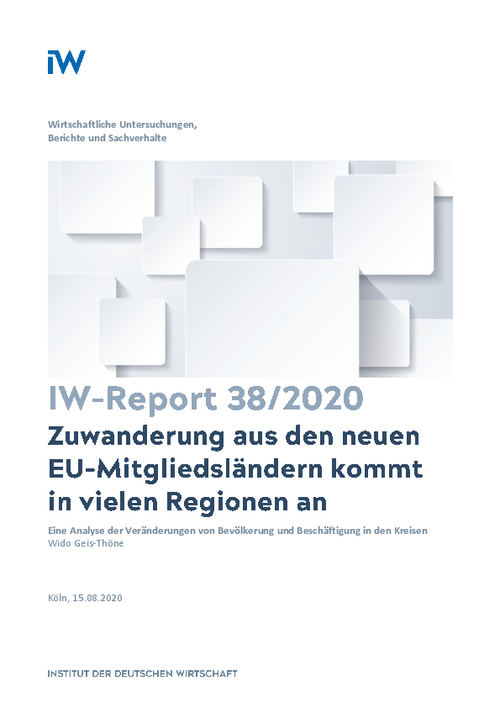In recent years there has been a very high level of immigration to Germany from the countries that joined the EU in 2004. On 31.12.2019 the total number of persons with the citizenship of these countries was 2.86 million, which was 744,000 more than on 31.12.2015 with 2.11 million.

Immigration From the New EU Member States Arrives in Many Regions: An Analysis of Changes in Population and Employment in the Counties
IW-Report

In recent years there has been a very high level of immigration to Germany from the countries that joined the EU in 2004. On 31.12.2019 the total number of persons with the citizenship of these countries was 2.86 million, which was 744,000 more than on 31.12.2015 with 2.11 million.
The number of Romanians increased particularly strongly with a plus of 296,000, followed by Bulgarians with a plus of 133,000, Poles with a plus of 122,000 and Croats with a plus of 117,000. Looking at the regional distribution of these immigrants, there are great differences between the countries of origin. The Romanians live predominantly in southern Germany and western Lower Saxony, while the Poles are often found in the northern part of the Federal Republic and the Croats are concentrated in the south. Unlike other immigrant groups, there is no focus on the larger cities. If one examines the determinants of the choice of destination of people from the new EU member states by means of multivariate analyses, it becomes clear that social networks from the countries of origin are of decisive importance. For example, the number of EU foreigners per 100,000 inhabitants in an administrative district on 31.12.2015 increased by 31.7 more in the period between 31.12.2015 and 31.12.2019 under otherwise equal conditions if it was 100 higher at the starting point. This finding is of great importance for regional migration policy, since it can be deduced from it that under certain conditions stronger migration processes can be initiated by establishing first small communities from a region of origin. Thus, more elaborate measures to attract people from abroad can pay off, although they would be uneconomic without this second-round effect.

Wido Geis-Thöne: Zuwanderung aus den neuen EU-Mitgliedsländern kommt in vielen Regionen an – Eine Analyse der Veränderungen von Bevölkerung und Beschäftigung in den Kreisen
IW-Report

More on the topic

Record immigration not only due to flight from Ukraine
In 2022, more people immigrated to Germany than ever before in the history of the Federal Republic. Around 1.46 million more people moved here than left the country, which is more than a quarter more than the previous record of 1.14 million from 2015.
IW
Immigration from Latin America: Successes and potential for securing skilled workers
Against the background of the baby boomers leaving the labour market, Germany will be increasingly dependent on skilled workers from abroad in the coming years in order to secure growth and prosperity.
IW